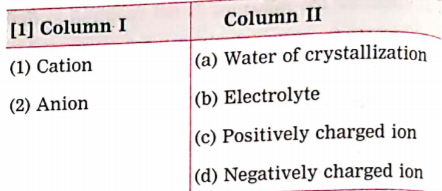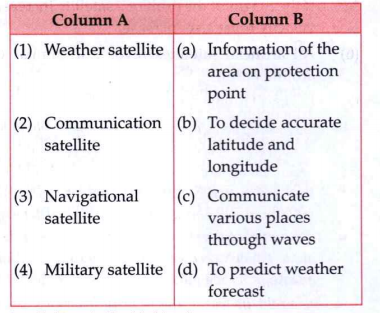Complete Solutions to EXERCISE of chapter ACIDS, BASES AND SALTS of Class 9 book with complete answers and questions
| Class 9 | CHEMISTRY |
| Chapter | ACIDS, BASES AND SALTS |
| NAVNEET PUBLICATION | EXERCISE |
| Number Of Questions | 100 |
| Academic Year | 2023-24 |
Fill in the blanks:
Ionic compound……..in aquoous solution.
View SolutionFill in the blanks:
…………..is a weak alkali.
View SolutionFill in the blanks:
The number of `H^+` ions obtained from one molecules of `H_3 PO_4` are ………..
View SolutionFill in the blanks:
The number of `OH^-` ions obtained from one molecule of `Ca(OH)_2` are ……..
View SolutionFill in the blanks:
The proportion of a solute in a solution is called the ……….of the solute.
View SolutionFill in the blanks:
When the concentration of a solute in its solution is low, it is a ………..solution.
View SolutionFill in the blanks:
In the ……….reaction, an acid reacts with a base to form a salt and water.
View SolutionFill in the blanks:
The pH of a basic solution is………than 7.
View SolutionFill in the blanks:
The separation of ions from an electrolyte is termed as…….
View SolutionFill in the blanks:
The positive terminal of an electrolytic cell is called.
View SolutionChoose the correct alternative and write it along with its alloted alphabet:
At what pH value is the solution considered to be acidic?
View SolutionChoose the correct alternative and write it along with its alloted alphabet:
What is the colour of a universal indicator in neutral solution?
View SolutionChoose the correct alternative and write it along with its alloted alphabet:
Which of the following solutions has pH more than 7?
View SolutionChoose the correct alternative and write it along with its alloted alphabet:
Which of the following has pH 7?
View SolutionChoose the correct alternative and write it along with its alloted alphabet:
Which of the following has pH 7?
View SolutionChoose the correct alternative and write it along with its allotted alphabet:
The reaction
View SolutionChoose the correct alternative and write it along with its alloted alphabet:
Phenolphthalein is …….
View SolutionChoose the correct alternative and write it along with its alloted alphabet:
When phenolphthalein is added to `NaOH`, the colour of the solution will become………
View SolutionChoose the correct alternative and write it along with its alloted alphabet:
When phenolphthalein is added to HCl, the colour of the solution will be……..
View SolutionChoose the correct alternative and write it along with its alloted alphabet:
……..is a natural indicator.
View SolutionChoose the correct alternative and write it along with its alloted alphabet:
The litmus paper or the litmus solution is obtained from…….plants.
View SolutionChoose the correct alternative and write it along with its alloted alphabet:
Which of the following is not required to find the pH of a given solution?
View SolutionChoose the correct alternative and write it along with its alloted alphabet:
………colour will be obtained by adding universal indicator in baking solution.
View SolutionChoose the correct alternative and write it along with its alloted alphabet :
`C_7H_16` is ……………...
View SolutionState whether the following statements are true or false:
Acids have bitter taste.
View SolutionState whether the following statements are true or false :
Benzene is an aromatic compound.
View SolutionState whether the following statements are true or false:
pH scale helps in measuring hydrogen ion concentration in a solution.
View SolutionState whether the following statements are true or false:
The pH of rain water is 7.
View SolutionState whether the following statements are true or false:
Salts of strong acids and strong bases are basic with the pH value greater than 7.
View SolutionState whether the following statements are true or false:
Salts of strong acids and strong bases are basic with the pH value greater than 7.
View SolutionState whether the following statements are true or false:
KCI is a stable ionic compound.
View SolutionState whether the following statements are true or false:
The bases which are highly soluble in water are called alkali.
View SolutionState whether the following statements are true or false:
Sodium chloride is a crystalline compound.
View SolutionState whether the following statements are true or false:
During electrolysis of water, hydrogen gas is formed near the anode.
View SolutionFind the odd man out:
Chloride, nitrate, hydride, ammonium
View SolutionFind the odd out and give reason:
Citric acid, formic acid, lactic acid, nitric acid.
View SolutionFind the odd one out
View SolutionFind the odd out and give reason:
Ammonium chloride, sodium chloride, potassium nitrate, sodium sulphate.
View SolutionFind the odd out and give reason:
Sodium nitrate, sodium carbonate, sodium sulphate, sodium chloride.
View SolutionSelect the odd man out
Calcium oxide, magnesium oxide, zinc oxide, sodium oxide.
View SolutionWrite the chemical formula and select the odd man out in the following solids:
Crystalline blue vitriol, crystalline common salt, crystalline ferrous sulphate, crystalline sodium carbonate.
View SolutionWrite the chemical formula for the following:
Sodium chloride, potassium hydroxide, acetic acid, sodium acetate.
View SolutionFind the odd one out
View SolutionFind the odd out and give reason:
NaOH, `Ca(OH)_2`, `NH_4 OH`, `Ba(OH)_2`
View SolutionFind the odd one out
View SolutionFind the odd out and give reason:
Citric acid, formic acid, lactic acid, nitric acid.
View SolutionMatch the following :

View SolutionMatch the following :

View SolutionDefine acid base according to Bronsted-Lowry theory.
View SolutionDefine acid base according to Bronsted-Lowry theory.
View SolutionDefine capacity of a conductor . State and define S.I. unit of capacity of conductor
View SolutionDefine acidity of bases.
View SolutionDefine universal indicator.
View SolutionDefine pH and pOH. Derive relationship between pH and pOH.
View SolutionDefine Neutalization.
View SolutionDefine electrolytes.
View SolutionWhat is the difference between electrolytic cell and voltaic cell?
View SolutionExplain by drawing a figure of the electronic configuration.
Formation of sodium chloride from sodium and chlorine.
View SolutionExplain by drawing a figure of the electronic configuration.
Formation of Magnesium chloride from magnesium and chlorine.
View SolutionAnswer the following questions:
Explain the dissociation of an ionic compound?
View SolutionAnswer the following questions:
What is meant by strong acid ? Give two examples.
View SolutionAnswer the following questions:
What is meant by weak acid? Give two examples.
View SolutionAnswer the following questions:
What is meant by strong base? Give two examples.
View SolutionAnswer the following questions:
What is meant by weak base? Give an example.
View SolutionAnswer the following questions:
What is meant by weak acid? Give two examples.
View SolutionAnswer the following questions:
What is meant by a cathode?
View SolutionAnswer the following questions:
What is meant by a concentrated solution?
View SolutionAnswer the following questions:
what is meant by a dilute solution?
View SolutionClassify the acids according to their basicity and give one example of each type.
View SolutionAnswer the following questions:
What is meant by an anode?
View SolutionAnswer the following questions:
What type of compound is a metal oxide, with reference to neutralization reaction?
View SolutionAnswer the following questions:
What is the difference in the pH of pure water and rain water? If it is so, explain.
View SolutionAnswer the following questions:
How do you measure pH on a pH scale?
View SolutionAnswer the following questions:
What would be the pH of a salt of a strong acid and a strong base?
View SolutionAnswer the following questions:
What would be the pH of a salt of a weak acid and a strong base?
View SolutionAnswer the following questions:
What is the pH range of human blood at which it works?
View SolutionAnswer the following questions:
Classify aqueous solutions of the following substances according to their pH into three groups: 7, more than 7, less than 7.
Common salt, sodium acetae, hydrochloric acid, carbon dioxide, potassium bromide, calcium hydroxide, ammonium chloride, vinegar, sodium carbonate, ammonium, sulphur dioxide.
View SolutionAnswer the following questions:
Write a note on pH scale.
View SolutionAnswer the following questions:
How does a metal react with an acid?
View SolutionAnswer the following questions:
How to metal oxides react with acid?
View SolutionAnswer the following question:
How does a computer work?
View SolutionAnswer the following questions :
Explain the structure of Benzene.
View SolutionAnswer the following questions:
Classify the following oxide into three types and name the types.
CaO, MgO, `CO_2`, `SO_3`, `Na_2 O`, ZnO, `Al_2 O_3`, `Fe_2 O_3`
View SolutionAnswer the following questions:
How do metal carbonates and bicarbonates react with acid? Reaction of acids with carbonates and bicarbonates of metals
View SolutionUse your brain power
Classify the following salts into the types acidic, basic and neutral, sodium sulphate, potassium chloride, ammonium nitrate, sodium carbonate, sodium acetate, sodium chloride.
View SolutionAnswer the following questions:
Classify the following salts into the types acidic, basic and neutral
Potassium sulphate
View SolutionAnswer the following questions:
Classify the following salts into the types acidic, basic and neutral
Ammonium chloride
View SolutionAnswer the following questions:
Classify the following salts into the types acidic, basic and neutral
Potassium acetate
View SolutionAnswer the following questions:
Classify the following salts into the types acidic, basic and neutral
Potassium acetate
View SolutionAnswer the following questions:
Classify the following salts into the types acidic, basic and neutral
calcium chloride.
View SolutionAnswer the following question:
What is meant by soap?
View SolutionAnswer the following questions:
Name two crystalline salts that contain water of crystallization. what would you observe ,When water of crystallization is lost from these salts.
View SolutionAnswer the following questions:
What is wave?
View SolutionAnswer the following questions:
What is meant by a cathode?
View SolutionAnswer the following questions:
What is meant by an anode?
View SolutionAnswer the following questions:
State the different uses of an electrolyte.
View SolutionAnswer the following questions :
What is meant by copolymers?
View SolutionAnswer the following questions:
Show the dissociation of the following compounds on dissolvinf in water, with the help of chemical equation and write whether the proportion of dissociation is small or large. Hydrochloric acid, sodium chloride, potassium hydroxide, ammonia, acetic acid, magnesium chloride, copper sulphate.
View SolutionWhat are the names of the following compounds?
`NH_3,Na_2O,CaO`
View SolutionUse your brain power
When the above compounds are mixed with water they combine with water. Complete the following table by writing the ions formed by their combination with water.
`NH_(3(g))+H_2 O_(l) to NH_4(aq)^+ +OH_(aq)^-` .
`Na_2 O_(s)+……to 2Na_(aq)^+ +……` .
`CaO_(s)+H_2 O_(l) to ........ +……`
View Solution
EXERCISE questions and complete solutions for chapter ACIDS, BASES AND SALTS of NAVNEET PUBLICATION of Class 9